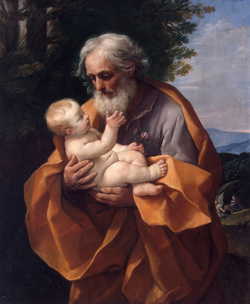|
As a young Catholic, all I knew about St. Joseph is what the nuns taught us: that he was a foster parent to Jesus; he worked as a carpenter; and that if your parents were selling their home, burying a little statue of him upside down in your garden would help get a buyer. As a grown man and a father to my Lucas, I realize that St. Joseph's real strength was as a father... He must have been a man of great faith and trust and love to accept Jesus as his own son.  St. Joseph with his new son St. Joseph with his new son La Festa di San Giuseppe (Feast of St. Joseph) on March 19th in Italy is a saint day celebrating the mortal father of Jesus--namely, Joseph. There are two meanings for this day in Italy: as a Name Day to celebrate anyone with the name Giuseppe, Joseph, Josephine or Beppe, but also as La Festa del Papà (alternately, la Festa del Babbo), on which most Italians celebrate their fathers, as we do on Fathers Day. There are some interesting ways to celebrate, but of course, most involve food. For instance, artichokes come to market in March in Italy, so eating artichokes stuffed with a breadcrumb mixture is one way... the breadcrumbs represent sawdust, honoring St. Joseph's life as a carpenter. On St. Joseph's day, tradition calls for sprinkling breadcrumbs on pasta dishes rather than cheese. Then there is Pane di San Giuseppe in which bread dough is fashioned into crosses and other various shapes. Another cerebration dish to make to celebrate St. Joseph or your Dad (my father would have loved this) is to make Pasta cod Sarde (Pasta with Sardines), a traditional meal made with bucatini (hollow, spaghetti-like pasta), raisins, pignoli nuts, fennel, onions and sardines. Then there are the sweet treats... mainly sfinci (alt, sfinge). Some are made like profiteroles or cream puffs and stuffed or topped with either a custard or a sweet ricotta filling and topped with a sour cherry, while others are more like bready, sugared zeppole, some stuffed, some not. There are also others called Zeppole di San Giuseppe that are not bready like what we Italian-Americans buy at Italian festivals called zeppole but are like cream puffs. Bottom line, there are lots of sweets that are made to celebrate St. Joseph's Day, and in Italy, the word "zeppole" is used fairly broadly to refer to many types of fried or baked donuts. In Sicily, during the Middle Ages, people prayed to St. Joseph to bring rain and save them from starvation and drought. The rains came and so did the fava bean crop, which saved the people. Still today, fava beans are part of celebrating St. Joseph--by eating Maccu (a fava bean soup) and carrying a fava bean that has been blessed by a priest in their pocket for good fortune. In the United States, a tradition of wearing red clothing was started to offset the proximity of St. Patrick's Day on which people wear green. Apparently, there is no religious or other significance of wearing red on St. Joseph's Day. On Saturday night for St. Joseph's Day, and to honor my Dad I made a special pizza--a traditional Sfincione which was covered with breadcrumbs on top. My Dad was not a great carpenter, but always loved working with wood and his hands. When I was a boy, he held the wood as I would try using the saw. He was a truly great father, never judging, always there for me. Dad, you would have loved a couple of slices of Sfincione... We miss your smile, Sally Boy...
0 Comments
Your comment will be posted after it is approved.
Leave a Reply. |
Categories
All
Archive
June 2024
|












 RSS Feed
RSS Feed
